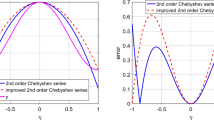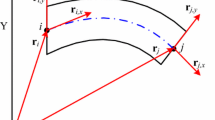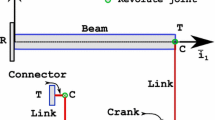Abstract
A non-intrusive computation methodology is proposed to study the dynamics of rigid–flexible multibody systems with a large number of uncertain interval parameters. The rigid–flexible multibody system is meshed by using a unified mesh of the absolute nodal coordinate formulation (ANCF). That is, the flexible parts are meshed by using the finite elements of the ANCF, while the rigid parts are described via the ANCF reference nodes (ANCF-RNs). Firstly, the interval differential-algebraic equations are directly transformed into the nonlinear interval algebraic equations by using the generalized-alpha algorithm. Then, the Chebyshev sampling methods, including Chebyshev tensor product sampling method and Chebyshev collocation method, are used to transform the nonlinear interval algebraic equations into sets of nonlinear algebraic equations with deterministic sampling parameters. The proposed computation methodology is non-intrusive because the original generalized-alpha algorithm is not amended. OpenMP directives are also used to parallelize the solving process of these deterministic nonlinear algebraic equations. To circumvent the interval explosion problem and maintain computation efficiency, the scanning method is used to determine the upper and lower bounds of the deducted Chebyshev surrogate models. Finally, two numerical examples are studied to validate the proposed methodology. The first example is used to check the effectiveness of the proposed methodology. And the second one of a complex rigid–flexible robot with uncertain interval parameters shows the effectiveness of the proposed computation methodology in the dynamics analysis of complicated spatial rigid–flexible multibody systems with a large number of uncertain interval parameters.





















Similar content being viewed by others
Abbreviations
- \(\mathbf{q}\) :
-
Nodal coordinates
- \(\mathbf{M}\) :
-
System mass matrix
- \(\mathbf{S}^{kr}\) :
-
Transformation matrix of ANCF-RN
- \(\varvec{\upomega }\) :
-
ANCF-RN angular velocity
- \(\varvec{\upalpha }\) :
-
ANCF-RN angular acceleration
- \(\mathbf{T}\) :
-
External torque
- \(\varvec{\Phi }\) :
-
System constraint equations
- \(\mathbf{Q}\) :
-
External force vector
- \(\mathbf{V}\) :
-
Solution vector of deterministic dynamics systems
- \(\varvec{\upzeta }\) :
-
Deterministic system parameter vector
- \({[}\varvec{\varsigma }{]}\) :
-
Interval parameter vector
- \({[}\hat{{\mathbf{V}}}{]}\) :
-
Interval solution vector of uncertain dynamics system
- \(\phi _j \) :
-
Chebyshev interpolation points
- \(\mathbf{U}\) :
-
Chebyshev polynomial vector
- \(C_p (x)\) :
-
Chebyshev polynomial of degree p
- \(\hat{{C}}_{a_1 a_2 \ldots a_k } \left( \mathbf{x} \right) \) :
-
k-dimensional Chebyshev polynomial
- \(\varvec{\Psi }\) :
-
CTP sample vectors
- \(\hat{\mathbf{K}}\) :
-
CTP surrogate coefficient matrix
- \(\hat{\mathbf{U}}\left( \mathbf{x} \right) \) :
-
CTP polynomial vector
- \(\hat{\varvec{\Psi }}\) :
-
CCM sample vectors
- \(\hat{\hat{\mathbf{K}}}\) :
-
CCM surrogate coefficient matrix
- \(\hat{\hat{\mathbf{U}}}\left( \mathbf{x} \right) \) :
-
CCM polynomial vector
References
Benosman, M., Vey, G.L.: Control of flexible manipulators: a survey. Robotica 22, 533–545 (2004)
Dwivedy, S.K., Eberhard, P.: Dynamic analysis of flexible manipulators—a literature review. Mech. Mach. Theory 41, 749–777 (2006)
Shabana, A.A.: Flexible multibody dynamics review of past and recent developments. Multibody Syst. Dyn. 1(2), 189–222 (1997)
Gerstmayr, J., Sugiyama, H., Mikkola, A.: Review on the absolute nodal coordinate formulation for large deformation analysis of multibody systems. J. Comput. Nonlinear Dyn. 8(3), 031016–031016-12 (2013)
Eberhard, P., Schiehlen, W.: Computational dynamics of multibody systems history, formalisms, and applications. J. Comput. Nonlinear Dyn. 1, 3–12 (2006)
Schiehlen, W.: Research trends in multibody system dynamics. Multibody Syst. Dyn. 18, 3–13 (2007)
Shabana, A.A., Yakoub, R.Y.: Three dimensional absolute nodal coordinate formulation for beam elements: theory. J. Mech. Des. 123(4), 606–613 (2000)
Yakoub, R.Y., Shabana, A.A.: Three dimensional absolute nodal coordinate formulation for beam elements: implementation and applications. J. Mech. Des. 123(4), 614–621 (2000)
Sugiyama, H., Suda, Y.: A curved beam element in the analysis of flexible multi-body systems using the absolute nodal coordinates. Proc. IMechE Part K J. Multi-body Dyn. 221(2), 219–231 (2007)
Shabana, A.A., Christensen, A.P.: Three-dimensional absolute nodal co-ordinate formulation plate problem. Int. J. Numer. Methods Eng. 40, 2775–2790 (1997)
Dufva, K., Shabana, A.A.: Analysis of thin plate structures using the absolute nodal coordinate formulation. Proc. IMechE Part K J. Multi-body Dyn. 219, 345–355 (2005)
Shabana, A. A.: ANCF reference node for multibody system analysis. Proc. Inst. Mech. Eng. Part K: J. Multi-body Dyn. Technical Note (2014). doi: 10.1177/1464419314546342
Shabana, A.A.: ANCF tire assembly model for multibody system applications. J. Comput. Nonlinear Dyn. 10(1), 024504–024504-4 (2015)
Pappalardo, C.M.: A natural absolute coordinate formulation for the kinematic and dynamic analysis of rigid multibody systems. Nonlinear Dyn. 81, 1841–1869 (2015)
Tian, Q., Xiao, Q.F., Sun, Y.L., Hu, H.Y., Liu, H., Flores, P.: Coupling dynamics of a geared multibody system supported by ElastoHydroDynamic lubricated cylindrical joints. Multibody Syst. Dyn. 33(3), 259–284 (2015)
Isukapalli, S.S.: Uncertainty Analysis of Transport-Transformation Models. The State University of New Jersey, New Brunswick (1999)
Wu, J.L., Luo, Z., Zhang, Y.Q., Zhang, N., Chen, L.: Interval uncertain method for multibody mechanical systems using Chebyshev inclusion functions. Int. J. Numer. Methods Eng. 95(7), 608–630 (2013)
Fishman, G.S.: Monte Carlo: Concepts, Algorithms, and Applications. Springer, New York (1996)
Jensen, H.A., Valdebenito, M.A.: Reliability-based optimization of stochastic systems using line search. Comput. Methods Appl. Mech. Eng. 198, 3915–3924 (2009)
Myers, R.H., Montgomery, D.C., Anderson-Cook, C.M.: Response surface methodology: process and product optimization using designed experiments. Technometrics 38(3), 284–286 (1996)
Ghanem, R., Spanos, P.: Polynomial chaos in stochastic finite element. J. Appl. Mech. 57(1), 197–202 (1990)
Tatang, M.A.: Combined Stochastic and Deterministic Approach in Solving Stochastic Differential Equations. Carnegie Mellon University, Pittsburgh, Commonwealth of Pennsylvania (1992)
Tatang, M.A.: Direct Incorporation of Uncertainty in Chemical and Environmental Engineering Systems. Massachusetts Institute of Technology, Cambridge (1995)
Xiu, D., Karniadakis, G.E.: Modeling uncertainty in flow simulations via generalized polynomial chaos. J. Comput. Phys. 187(1), 137–167 (2002)
Kewlani, G., Iagnemma, K.: A stochastic response surface approach to statistical prediction of mobile robot mobility. IEEE/RSJ. In: Proceedings of the International Conference on Intelligent Robots and Systems, Nice, France. pp. 2234–2239 (2008)
Sandu, A., Sandu, C., Ahmadian, M.: Modeling multibody systems with uncertainties. Part I: theoretical and computational aspects. Multibody Syst. Dyn. 15(4), 369–391 (2006)
Sandu, C., Sandu, A., Ahmadian, M.: Modeling multibody systems with uncertainties. Part II: numerical applications. Multibody Syst. Dyn. 15(3), 241–262 (2006)
Negrut, D., Jay, L.O., Khude, N.: A discussion of low-order numerical integration formulas for rigid and flexible multibody dynamics. J. Comput. Nonlinear Dyn. 4(2), 021008–021008-11 (2007)
Revol, N., Makino, K., Berz, M.: Taylor models and floating-point arithmetic: proof that arithmetic operations are validated in COSY. J. Logic Algebr. Program. 64(1), 135–154 (2005)
Moore, R.E.: Interval Analysis. Prentice-Hall, Englewood Cliffs (1966)
Gao, W.: Natural frequency and mode shape analysis of structures with uncertainty. Mech. Syst. Signal Process. 21(1), 24–39 (2007)
Wu, J.L., Zhang, Y.Q., Chen, L.P., Luo, Z.: A Chebyshev interval method for nonlinear dynamic systems under uncertainty. Appl. Math. Model. 37(6), 4578–4591 (2013)
Wu, J.L., Luo, Z., Zhang, Y.Q., Zhang, N., Chen, L.P.: Interval uncertain method for multibody mechanical systems using Chebyshev inclusion functions. Int. J. Numer. Methods Eng. 95(7), 608–630 (2013)
Alefeld, G.: Interval analysis: theory and applications. J. Comput. Appl. Math. 121, 421–464 (2000)
Jackson, K.R., Nedialkov, N.S.: Some recent advances in validated methods for IVPs for ODEs. Appl. Numer. Math. 42(1–3), 269–284 (2002)
Makino, K., Berz, M.: Efficient control of the dependency problem based on Taylor model methods. Reliab. Comput. 5(1), 3–12 (1999)
Wu, J.L., Zhao, Y., Chen, S.: An improved interval analysis method for uncertain structures. Struct. Eng. Mech. 20(6), 713–726 (2005)
Lin, Y., Stadtherr, M.A.: Validated solutions of initial value problems for parametric ODEs. Appl. Numer. Math. 57(10), 1145–1162 (2007)
Warten, R.M.: Automatic step-size control for Rung–Kutta integration. IBM J. Res. Dev. 7(4), 340–341 (1963)
Newmark, N.M.: A method of computation for structural dynamics. ASCE J. Eng. Mech. Div. 85, 67–94 (1959)
Negrut, D., Rampalli, R., Ottarsson, G., Sajdak, A.: On an implementation of the Hilber–Hughes–Taylor method in the context of index 3 differential-algebraic equations of multibody dynamics. ASME J. Comput. Nonlinear Dyn. 2(1), 73–85 (2007)
Arnold, M., Brüls, O.: Convergence of the generalized-\(\alpha \) scheme for constrained mechanical systems. Multibody Syst. Dyn. 18(2), 185–202 (2007)
Wu, J.L., Luo, Z., Zhang, N., Zhang, Y.Q.: A new interval uncertain optimization method for structures using Chebyshev surrogate models. Comput. Struct. 146, 185–196 (2015)
Buras, A.J., Jamin, M., Lautenbacher, M.: A 1996 analysis of the CP. Violating ratio \(\varepsilon ^{\prime }/\varepsilon \). Phys. Lett. B. 389(4), 749–756 (1996)
Wu, J.L., Luo, Z., Zhang, N., Zhang, Y.Q.: A new sampling scheme for developing metamodels with the zeros of Chebyshev polynomials. Eng. Optim. 47(9), 1264–1288 (2014)
Jalon, J., Bayo, E.: Kinematic and Dynamic Simulation of Multibody Systems. Springer, Berlin (2012)
Jalón, J.G.D.: Twenty-five years of natural coordinates. Multibody Syst. Dyn. 18(1), 15–33 (2007)
García-Vallejo, D., Escalona, J.L., Mayo, J., Domínguez, J.: Describing rigid–flexible multibody systems using absolute coordinates. Nonlinear Dyn. 34(1–2), 75–94 (2003)
Shabana, A.A.: Dynamics of Multibody Systems. Cambridge University Press, Cambridge (2005)
Sopanen, J., Mikkola, A.: Description of elastic forces in absolute nodal coordinate formulation. Nonlinear Dyn. 34, 53–74 (2003)
Gerstmayr, J., Matikainen, M.K., Mikkola, A.M.: A geometrically exact beam element based on the absolute nodal coordinate formulation. Multibody Sys. Dyn. 20, 359–384 (2008)
Shen, Z., Li, P., Liu, C., Hu, G.: A finite element beam model including cross-section distortion in the absolute nodal coordinate formulation. Nonlinear Dyn. 77, 1019–1033 (2014)
García-Vallejo, D., Mayo, J., Escalona, J.L., Domínguez, J.: Three-dimensional formulation of rigid–flexible multibody systems with flexible beam elements. Multibody Syst. Dyn. 20(1), 1–28 (2008)
Hong, J.Z.: Computational Dynamics of Multibody Systems. Higher Education Press, Beijing (1999). (in Chinese)
Liu, C., Tian, Q., Hu, H.Y., García-Vallejo, D.: Simple formulations of imposing moments and evaluating joint reaction forces for rigid–flexible multibody systems. Nonlinear Dyn. 69, 127–147 (2012)
Liu, C., Tian, Q., Hu, H.Y.: Dynamics and control of a spatial rigid–flexible multibody system with multiple cylindrical clearance joints. Mech. Mach. Theory 52, 106–129 (2012)
Jeffery, J.: Numerical Analysis and Scientific Computation. Addison Wesley, Boston (2004)
Liu, C., Tian, Q., Hu, H.Y.: Dynamics of a large scale rigid–flexible multibody system composed of composite laminated plates. Multibody Syst. Dyn. 26, 283–305 (2011)
Hussein, B., Negrut, D., Shabana, A.A.: Implicit and explicit integration in the solution of the absolute nodal coordinate differential/algebraic equations. Nonlinear Dyn. 54, 283–296 (2008)
Tian, Q., Zhang, Y.Q., Chen, L.P., Yang, J.: An efficient hybrid method for multibody dynamics simulation based on absolute nodal coordinate formulation. J. Comput. Nonlinear Dyn. 4, 021009 (2009)
Shabana, A.A., Hussein, B.: A two-loop sparse matrix numerical integration procedure for the solution of differential/algebraic equations: application to multibody systems. J. Sound Vib. 327, 557–563 (2009)
Hussein, B., Shabana, A.A.: Sparse matrix implicit numerical integration of the stiff differential/algebraic equation: implementation. Nonlinear Dyn. 65, 369–382 (2011)
Chung, J., Hulbert, G.: A time integration algorithm for structural dynamics with improved numerical dissipation: the generalized-alpha method. J. Mech. Appl. Math. 60, 371–375 (1993)
Tian, Q., Zhang, Y., Chen, L., Yang, J.: Simulation of planar flexible multibody systems with clearance and lubricated revolute joints. Nonlinear Dyn. 60, 489–511 (2010)
Tian, Q., Zhang, Y.Q., Chen, L.P., Flores, P.: Dynamics of spatial flexible multibody systems with clearance and lubricated spherical joints. Comput. Struct. 87, 913–929 (2009)
Liu, Z.Z., Wang, T.S., Li, J.F.: A trigonometric interval method for dynamic response analysis of uncertain nonlinear systems. Sci. China Phys. Mech. Astron. 58, 044501-1–044501-13 (2015)
Acknowledgments
This research was supported in part by National Natural Science Foundations of China under Grants 11290151 and 11472042. The research was also supported in part by the Beijing Higher Education Young Elite Teacher Project under Grant YETP1201.
Author information
Authors and Affiliations
Corresponding author
Rights and permissions
About this article
Cite this article
Wang, Z., Tian, Q. & Hu, H. Dynamics of spatial rigid–flexible multibody systems with uncertain interval parameters. Nonlinear Dyn 84, 527–548 (2016). https://doi.org/10.1007/s11071-015-2504-4
Received:
Accepted:
Published:
Issue Date:
DOI: https://doi.org/10.1007/s11071-015-2504-4




